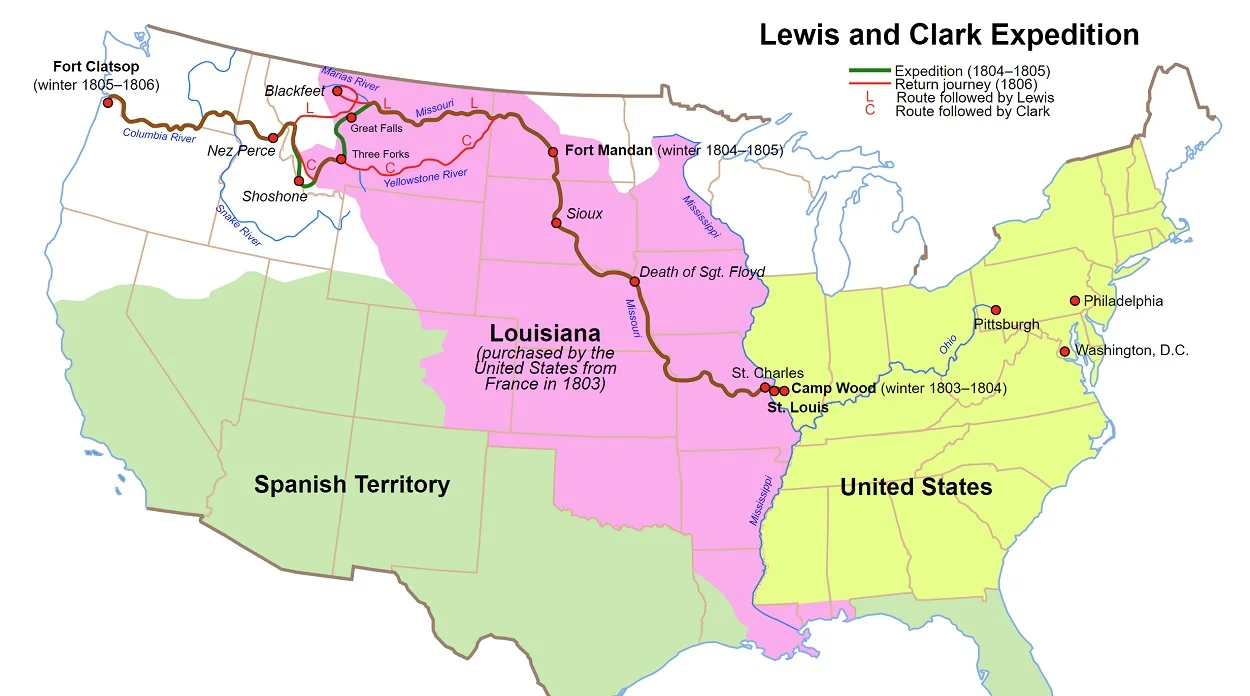Following the Louisiana Purchase by the United States from the French First Republic in 1803, President Thomas Jefferson commissioned an expedition westward to the Pacific Ocean to map the new territory.
The expedition’s purpose was to learn about the flora and fauna, to find a practical route across the western half of the continent, and to establish an American presence in the territory before European powers attempted to establish claims in the region.
To lead the expedition (which was nick-named the Corps of Discovery), Jefferson chose his personal secretary, 27-year-old Meriwether Lewis. To co-lead, Lewis chose his long-time friend, William Clark, who had previously served as a lieutenant during the Northwest Indian War.
Along with over 40 other explorers, Lewis and Clark began their journey in July of 1803, by traveling up the Mississippi to gather all the necessary supplies to sustain them on their 8,000-mile journey.

While Lewis, Clark and Sacajawea (the expedition’s interpreter and only woman) gained worldwide attention and historic notoriety for their journey, another important figure drew much less admiration and respect as his famous counterparts.
York was born a slave around 1770 and was owned by John Clark III (William’s father), who also owned several other members of York’s family. There is very little first-hand information about York’s early life, and much of our historical knowledge of him comes directly from Lewis and Clark’s (and other expedition members) personal journals, or in Indian oral tradition passed down until the 20th century.
We know that upon John Clark III’s death, York was bequeathed to William in his will: “I give and bequeath to my son Edmund… three slaves, to wit Peter (Vegas child), and Scipio and Darathy (Rose’s children)… I give and bequeath to my son William… one black man named York, also old York and his wife Rose, and their two children, Nancy and Juba; also three old ******, Tame, Cupid and Harry.”
Despite being the only African American on the expedition, the records from the trip show no apparent evidence of racial bias against York. He was allowed to vote along with other members on important decisions and was trusted to go out alone on scouting missions fully armed (something the enslaved were not ordinarily permitted). Clark even named two geographic discoveries after him; York’s Eight Islands and York’s Dry Creek.
York had many duties, including hunting and gathering food (in which the journals note his prowess in hunting buffalo, deer, and geese alike), portaging, building shelters, and caring for the sick or injured expedition members.
Perhaps York’s most important role was during the encounters with the native people, who had never seen a black man and considered his skin colour to be that of a warrior endowed with power and strength. York became the first point of contact with native tribes, often going out alone to scout and negotiate a successful trade.
On one encounter with the Hidasta tribe, Chief La Barge refused to believe that York’s skin colour was real, so he wet his own hand and tried to “remove the paint” from York’s skin. Another encounter was with the Shoshone tribe, who agreed to supply horses only on the condition of seeing York in person to prove that he really existed.
Two and a half years after leaving to explore the new country, the team returned home to receive money, fame and international recognition…All except York, who was treated again as a slave and refused his freedom.
In a letter to his brother, Clark wrote:
“I did wish to do well by him, but as he has got Such a notion about freedom and his emence [immense] Services, that I do not expect he will be of much Service to me again; I do not think with him, that his Services has been so great/or my Situation would promit me to liberate him”.
York was forced to return to St. Louis with Clark, where Clark found him “insolent and sulky”. Clark revealed that he freed a number of his slaves, including York, who he said began a business as a wagonner (although there is no evidence to confirm this). Clark, whose account betrays a clear prejudice by this point, claimed freedom was York’s downfall:
“He could not get up early enough in the morng [sic] – his horses were ill kept – two died – the others grew poor. He sold them, was cheated – entered into service – fared ill. Damn this freedom, said York, I have never had a happy day since I got it. He determined to go back to his old master – set off for St. Louis, but was taken with the cholera in Tennessee & died (1815).”
York was a true American explorer and pioneering figure, being the only African-American member of the Lewis and Clark Expedition; he participated in the entire exploration, and despite being an enslaved man, made significant contributions to its success.
Written by Julie St Jean
Header Image Credit : Shutterstock





